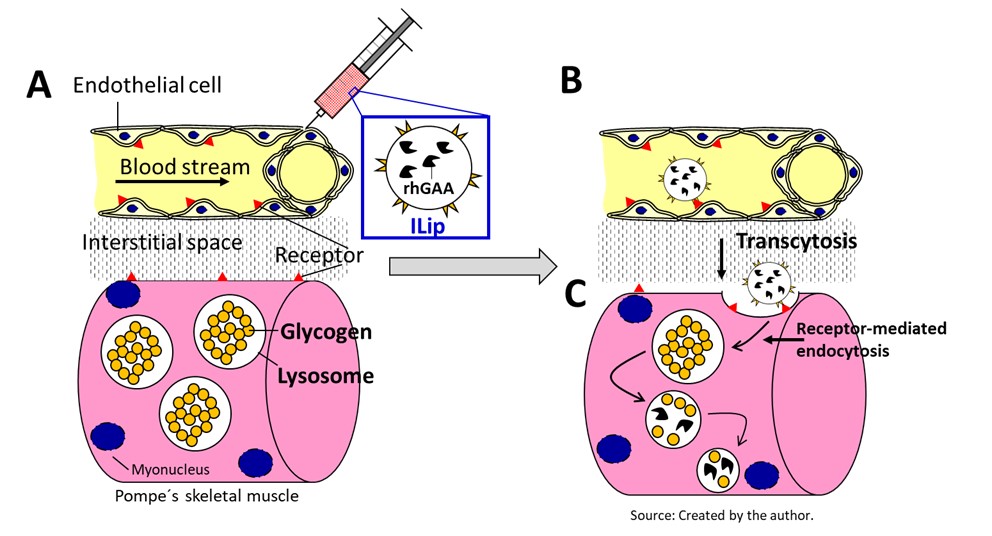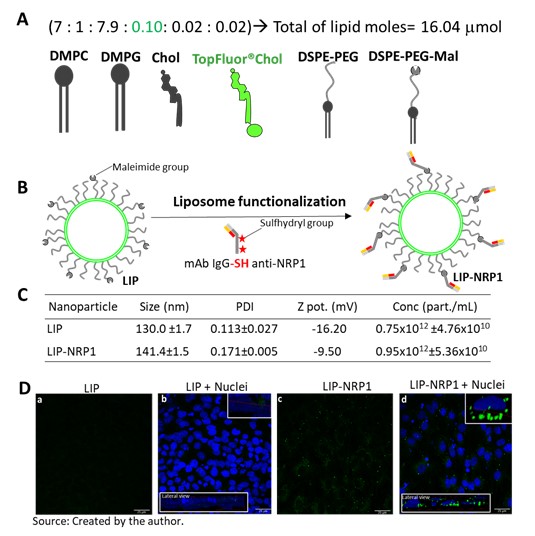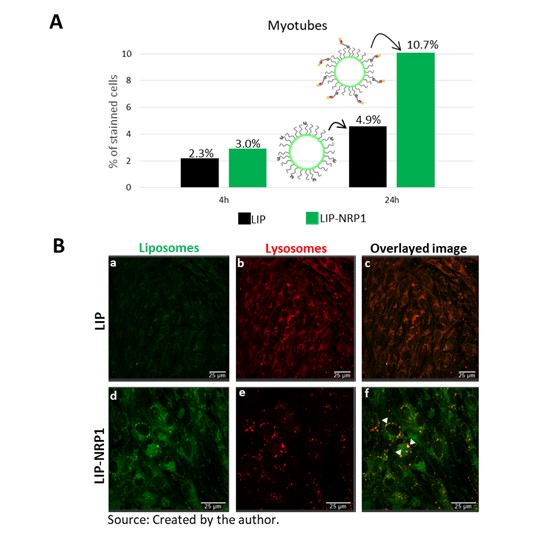Formulation and Delivery - Chemical
Category: Poster Abstract
(M1130-01-02) Development of Therapeutic Immunoliposome to Deliver Recombinant Human Enzyme for the Treatment of Pompe Disease
Monday, October 23, 2023
11:30 AM - 12:30 PM ET
- MB
M. Vitoria Lopes Badra Bentley, Ph.D. (she/her/hers)
University of Sao Paulo
Ribeiro Preto, Sao Paulo, Brazil - DC
Daniel Giuliano Giuliano Cerri, Ph.D. (he/him/his)
Universidade de Sao Paulo
Ribeirao Preto, Sao Paulo, Brazil - FG
Fabíola Silva Garcia Garcia (she/her/hers)
Universidade de Sao Paulo
Ribeirao Preto, Sao Paulo, Brazil - EC
Emanuel Carrilho, Ph.D. (he/him/his)
Universidade de Sao Paulo
Sao Carlos, Sao Paulo, Brazil
Presenting Author(s)
Main Author(s)
Co-Author(s)
Purpose: Metabolic lysosomal disorders such as Pompe disease are disabling pathologies characterized by defective lysosomal glycogen catabolism due to glycogen accumulation within lysosomes (Meena and Raben, 2020). Current FDA-approved enzyme replacement therapy fails to deliver recombinant human GAA (rhGAA) to muscle tissue due to poor cellular specificity and uptake. Here, we propose the use of functionalized liposomes (Di and Xie, 2020) for rhGAA encapsulation to enhance enzyme delivery to target muscle tissue, as seen in Figure 1A-C. Considering that muscle tissue has NRP1 receptors expressed in its cell membrane, we hypothesized that liposomes functionalized with anti-NRP1 (Immunoliposome) could become a new and effective therapeutic strategy for Pompe disease. Our goal is to characterize rhGAA-containing immunoliposomes for future combination with the Organ-on-a-Chip (OoC) platform (Ingber, 2022).
Methods: The preparation of immunoliposomes was carried out by the thin lipid film method with subsequent hydration, the physicochemical parameters were made by DLS (Size, Polydispersion Index and Zeta Potential) and NTA (Particle Concentration). Liposome functionalization (LIP) was performed by the simple reaction of the partially anti-NRP1 mAb (LIP-NRP1) with the maleimide group present in the liposome structure. The static-specific interaction was performed by incubating these liposomes with pre-fixed myotubes. On the other hand, the dynamics of absorption of nanoparticles (NPs) was tested by FACs and confirmed in confocal microscopy.
Results: The immunoliposome preparation steps were optimized by evaluating the temperature, lipid composition (Figure 2A) and time of film formation and extrusion cycles on the characteristics of the formed vesicles. Figure 2B shows the liposome functionalization scheme. The physical-chemical analysis (Figure 2C) of both NPs showed an optimal formulation with unimodal and symmetrical size distribution curves with a mean diameter of 130 to 140 nm. The polydispersion index varied between 0.110-0.170 indicating a narrow and homogeneous particle size distribution, while the zeta potential varied between -9.5 and -16.2 mV. By fluorescence confocal microscopy (Fig. 2D-a to f), we confirmed the static interaction of LIP-NRP1 with the plasmatic membrane of myotube cells. The dynamics of liposome uptake (Figure 3A) showed that after 24h of exposure, 10.7% of the traced LIP-NRP1 was taken up by the myotubes, compared to 4.9% in the non-functionalized liposome. Finally, by fluorescent confocal microscopy, these functionalized NPs were stained and co-localized within lysosomes (Figure 3 B-f). In the trials that follow, we will test LIP/LIP-NRP1 in vein-on-a-chip and muscle-on-a-chip platforms to assess its localization and bioavailability. These results confirm the potential of LIP-NRP1 for the encapsulation of rhGAA, which may increase its delivery to muscle tissues affected in Pompe disease. Thus, functionalized liposomes demonstrated greater uptake by myotubes, indicating their potential use as a biomolecule delivery system. In the near future, the use of the OoC platform in combination with endothelial and muscle cells will be analyzed by our research group to demonstrate the feasibility of the therapeutic strategy.
Conclusion: In conclusion, our study highlights the development of immunoliposomes as a new therapeutic strategy for the treatment of Pompe disease. Optimization of these NPs and functionalization with monoclonal antibodies have shown promising results, enhancing their uptake by myotubes and paving the way for new therapeutic applications in lysosomal pathologies.
References: -Di J, Xie F, Xu Y. When liposomes met antibodies: Drug delivery and beyond. Adv Drug Deliv
Rev. 2020;154-155:151-162. doi: 10.1016/j.addr.2020.09.003. Epub 2020 Sep 12. PMID:
32926944.
- Ingber DE. Human organs-on-chips for disease modelling, drug development and
personalized medicine. Nat Rev Genet. 2022 Aug;23(8):467-491. doi: 10.1038/s41576-022-
00466-9. Epub 2022 Mar 25. PMID: 35338360; PMCID: PMC8951665.
-Meena NK, Raben N. Pompe Disease: New Developments in an Old Lysosomal Storage
Disorder. Biomolecules. 2020 Sep 18; 10(9):1339. doi: 10.3390/biom10091339. PMID:
32962155; PMCID: PMC7564159.
Acknowledgements:This work was developed within the framework of National Institute of Science and Technology of Pharmaceutical Nanotechnology (INCT-Nanofarma), and supported by São Paulo Research Foundation (FAPESP, Brazil, grant #2014/50928-2) and Conselho Nacional de Desenvolvimento Científico e Tecnológico (CNPq, Brazil, grant #465687/2014-8). Daniel G. Cerri was recipient of USP-PIPAE Program fellowship.
 Figure 1. Immunoliposome (Ilip) should be injected intravenously (A), where it will bypass the endothelial tissue by transcytosis (B) , the interstitial space by Brownian movement and interacting with specific muscle receptor (C) by activating receptor-mediated endocytosis, which will deliver the enzyme to the lysosome.
Figure 1. Immunoliposome (Ilip) should be injected intravenously (A), where it will bypass the endothelial tissue by transcytosis (B) , the interstitial space by Brownian movement and interacting with specific muscle receptor (C) by activating receptor-mediated endocytosis, which will deliver the enzyme to the lysosome. Figure 2. (A) Fluorescent liposome composition; (B) Liposome functionalization with partially reduced anti-NRP1; (C) Physicochemical data obtained from control liposome (L488) and functionalized one (L488-NRP1) and; (D) Liposomes interaction with pre-fixed differentiated myotubes via confocal fluorescence microscopy, where (a and b)= L488 and (c and d)= L488-NRP1 and; (a) and (c) liposomes excitation only and (b) and (d) liposomes merged with nuclei staining and upper and bottom insets of lateral view. Note that only L488-NRP1 (d) showed a strong interaction with cell plasma membrane surface.
Figure 2. (A) Fluorescent liposome composition; (B) Liposome functionalization with partially reduced anti-NRP1; (C) Physicochemical data obtained from control liposome (L488) and functionalized one (L488-NRP1) and; (D) Liposomes interaction with pre-fixed differentiated myotubes via confocal fluorescence microscopy, where (a and b)= L488 and (c and d)= L488-NRP1 and; (a) and (c) liposomes excitation only and (b) and (d) liposomes merged with nuclei staining and upper and bottom insets of lateral view. Note that only L488-NRP1 (d) showed a strong interaction with cell plasma membrane surface. Where: DMPC=DipalMitoylPhosphatidylCholine; DMPG= 1,2-DiMyristoyl-sn-glycero-3-PhosphoGlycerol; Chol= Cholesterol; TopFluo®Chol=23-dipyrrometheneboron difluoride-24-norcholesterol; DSPE-PEG= 1,2-distearoyl-sn-glycero-3-phosphoethanolamine-N-[metoxy(polyethylene glycol)-2000]; DSPE-PEG-Mal= 1,2-distearoyl-sn-glycero-3-phosphoethanolamine-N-[maleimide(polyethylene glycol)-2000]; L488= Fluorescent liposome; L4988-NRP1= NRP-1 Functionalized fluorescent liposome; mAb IgG-SH anti-NRP-1= Partially reduced monoclonal antibody anti-NRP1
 Figure 3. Liposomes dynamic in uptake assays. (A) By Flow cytometry, it was showed that LIP-NRP1 is uptake practically the double than LIP after 24h of exposition and; (B) Confocal fluorescent microscopy of 24h exposition of liposomes into myotubes, where: (a-c) LIP, (d-f) LIP-NRP1; (a and d) Liposomes staining; (b and e) lysosome staining and (c and f) overlaid images. Note that LIP-NRP1 was delivered inside myotubes lysosomes as seen by the yellow staining in the overlaid image (f, arrowheads).
Figure 3. Liposomes dynamic in uptake assays. (A) By Flow cytometry, it was showed that LIP-NRP1 is uptake practically the double than LIP after 24h of exposition and; (B) Confocal fluorescent microscopy of 24h exposition of liposomes into myotubes, where: (a-c) LIP, (d-f) LIP-NRP1; (a and d) Liposomes staining; (b and e) lysosome staining and (c and f) overlaid images. Note that LIP-NRP1 was delivered inside myotubes lysosomes as seen by the yellow staining in the overlaid image (f, arrowheads).